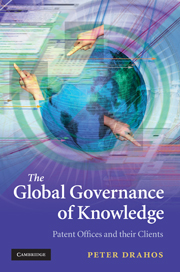Book contents
- Frontmatter
- Contents
- List of diagrams and tables
- List of abbreviations
- Preface
- 1 Patent offices and the global governance of knowledge
- 2 Labyrinths and catacombs: Patent office procedure
- 3 The rise of patent offices
- 4 The Sun and its planets: The European Patent Office and national offices
- 5 The USPTO and JPO
- 6 The age of Trilaterals and the spirit of cooperation
- 7 The jewel in the crown: India's Patent Office
- 8 The dragon and the tiger: China and South Korea
- 9 Joining the patent office conga line: Brazil
- 10 Islands and regions in the patent stream
- 11 Reclaiming the patent social contract
- 12 Patent administration sovereignty: Nodal solutions for small countries, developing countries
- Index
- References
5 - The USPTO and JPO
Published online by Cambridge University Press: 03 May 2010
- Frontmatter
- Contents
- List of diagrams and tables
- List of abbreviations
- Preface
- 1 Patent offices and the global governance of knowledge
- 2 Labyrinths and catacombs: Patent office procedure
- 3 The rise of patent offices
- 4 The Sun and its planets: The European Patent Office and national offices
- 5 The USPTO and JPO
- 6 The age of Trilaterals and the spirit of cooperation
- 7 The jewel in the crown: India's Patent Office
- 8 The dragon and the tiger: China and South Korea
- 9 Joining the patent office conga line: Brazil
- 10 Islands and regions in the patent stream
- 11 Reclaiming the patent social contract
- 12 Patent administration sovereignty: Nodal solutions for small countries, developing countries
- Index
- References
Summary
The USPTO
The USPTO is the oldest examining office in the world. As we saw in Chapter 3 the US committed itself to substantive examination in 1790 and has stayed with it, aside from its experiment with a registration-only system from 1793 to 1836. It has, therefore, the longest experience of the problems of an examination system. An examiner travelling in time from the nineteenth century to the USPTO building in twenty-first century Alexandria, Virginia would see, once he had gotten over the marvel of computers and automatically flushing toilets, the same basic problems that confronted the office in the nineteenth century. These problems include finding and classifying prior art, retaining a sufficient number of trained examiners, dealing with a backlog of applications and coping with the gaming behaviour of the users of the system. These problems have proved to be remarkably persistent.
The US patent system in the blink of an eye
The US patent system has deeper constitutional roots than other patent systems. Article I, Section 8, Clause 8 of the US Constitution states: ‘To promote the Progress of Science and Useful Arts, by securing for limited Times to Authors and Inventors the exclusive Right to their respective Writings and Discoveries.’ As one US Supreme Court decision has put it, by ‘constitutional command’ the patent system must serve the progress of useful arts. The clause is also consistent with the social value conception of the patent contract that was argued for in Chapter 1.
- Type
- Chapter
- Information
- The Global Governance of KnowledgePatent Offices and their Clients, pp. 144 - 176Publisher: Cambridge University PressPrint publication year: 2010
References
- 2
- Cited by



